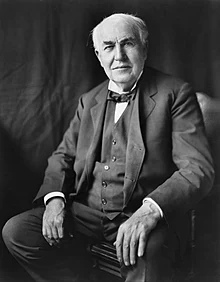Thomas Alva Edison (February 11, 1847 - October 18, 1931) was an American inventor and businessman. He developed many devices in fields such as electric power generation, mass communication, sound recording, and motion pictures. These inventions, which include the phonograph, the motion picture camera, and early versions of the electric light bulb, have had a widespread impact on the modern industrialized world. He was one of the first inventors to apply the principles of organized science and teamwork to the process of invention, working with many researchers and employees. He established the first industrial research laboratory.
Detail of Kinetoscope, made by Thomas Edison in 1894
Edison was raised in the American Midwest. Early in his career he worked as a telegraph operator, which inspired some of his earliest inventions. In 1876, he established his first laboratory facility in Menlo Park, New Jersey, where many of his early inventions were developed. He later established a botanical laboratory in Fort Myers, Florida, in collaboration with businessmen Henry Ford and Harvey S. Firestone, and a laboratory in West Orange, New Jersey, that featured the world's first film studio, the Black Maria. With 1,093 US patents in his name, as well as patents in other countries, Edison is regarded as the most prolific inventor in American history. Edison married twice and fathered six children. He died in 1931 of complications of diabetes.
Edison was granted a patent for a motion picture camera, labeled the "Kinetograph". He did the electromechanical design while his employee William Kennedy Dickson, a photographer, worked on the photographic and optical development. Much of the credit for the invention belongs to Dickson. In 1891, Thomas Edison built a Kinetoscope or peep-hole viewer. This device was installed in penny arcades, where people could watch short, simple films. The kinetograph and kinetoscope were both first publicly exhibited May 20, 1891.
In April 1896, Thomas Armat's Vitascope, manufactured by the Edison factory and marketed in Edison's name, was used to project motion pictures in public screenings in New York City. Later, he exhibited motion pictures with voice soundtrack on cylinder recordings, mechanically synchronized with the film.
Officially the kinetoscope entered Europe when wealthy American businessman Irving T. Bush (1869-1948) bought from the Continental Commerce Company of Frank Z. Maguire and Joseph D. Baucus a dozen machines. Bush placed from October 17, 1894, the first kinetoscopes in London. At the same time, the French company Kinétoscope Edison Michel et Alexis Werner bought these machines for the market in France. In the last three months of 1894, the Continental Commerce Company sold hundreds of kinetoscopes in Europe (i.e. the Netherlands and Italy). In Germany and in Austria-Hungary, the kinetoscope was introduced by the Deutsche-österreichische-Edison-Kinetoscop Gesellschaft, founded by the Ludwig Stollwerck of the Schokoladen-Süsswarenfabrik Stollwerck & Co of Cologne.
The first kinetoscopes arrived in Belgium at the Fairs in early 1895. The Edison's Kinétoscope Français, a Belgian company, was founded in Brussels on January 15, 1895, with the rights to sell the kinetoscopes in Monaco, France and the French colonies. The main investors in this company were Belgian industrialists. On May 14, 1895, the Edison's Kinétoscope Belge was founded in Brussels. Businessman Ladislas-Victor Lewitzki, living in London but active in Belgium and France, took the initiative in starting this business. He had contacts with Leon Gaumont and the American Mutoscope and Biograph Co. In 1898, he also became a shareholder of the Biograph and Mutoscope Company for France.
Edison's film studio made nearly 1,200 films. The majority of the productions were short films showing everything from acrobats to parades to fire calls including titles such as Fred Ott's Sneeze (1894), The Kiss (1896), The Great Train Robbery (1903), Alice's Adventures in Wonderland (1910), and the first Frankenstein film in 1910. In 1903, when the owners of Luna Park, Coney Island announced they would execute Topsy the elephant by strangulation, poisoning, and electrocution (with the electrocution part ultimately killing the elephant), Edison Manufacturing sent a crew to film it, releasing it that same year with the title Electrocuting an Elephant.
As the film business expanded, competing exhibitors routinely copied and exhibited each other's films. To better protect the copyrights on his films, Edison deposited prints of them on long strips of photographic paper with the U.S. copyright office. Many of these paper prints survived longer and in better condition than the actual films of that era.
In 1908, Edison started the Motion Picture Patents Company, which was a conglomerate of nine major film studios (commonly known as the Edison Trust). Thomas Edison was the first honorary fellow of the Acoustical Society of America, which was founded in 1929.
Edison said his favorite movie was The Birth of a Nation. He thought that talkies had "spoiled everything" for him. "There isn't any good acting on the screen. They concentrate on the voice now and have forgotten how to act. I can sense it more than you because I am deaf." His favorite stars were Mary Pickford and Clara Bow.




No comments:
Post a Comment